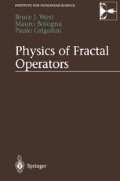Abstract
At the turn of the century there were two opposing points of view in physics, the atomists and the antiatomists. The latter camp believed in the continuity of nature and saw no reason why matter should stop being divisible at the level of the atom and should, they reasoned, continue indefinitely to smaller and smaller scales. The atomists, on the other hand, with the successes of the periodic table and the kinetic theory of gases, had Boltzmann as their chief proponent. Boltzmann was such an extreme atomist that he did not even accept the continuity of time. In his St. Louis lecture in 1904 he stated [1]:
Perhaps our equations are only very close approximations to average values that are made up of much finer elements and are not strictly differentiable.
Access this chapter
Tax calculation will be finalised at checkout
Purchases are for personal use only
Preview
Unable to display preview. Download preview PDF.
Bibliography
E. Broda, Ludwig Boltzmann, Man-Physicist-Philosopher, Ox Bow, Woodbridge (1983).
H. Goldstein, Advanced Classical Mechanics, John Wiley, New York, first edition (1955).
P. Meäkin, Fractals, scaling and growth far from equilibrium, Cambridge Nonlinear Science Series 5, Cambridge University Press, Cambridge, MA (1998).
K. S. Miller and B. Ross, An Introduction to the Fractional Calculus and Fractional Differential Equations, John Wiley, New York (1993).
D. Ruelle, Chaotic Evolution and Strange Attractors, Cambridge University Press, Cambridge (1989).
Yu. N. Rabotnov, Elements of Hereditary Solid Mechanics, MIR, Moscow (1980).
S. G. Samko, A. A. Kilbas and O. I. Marichev, Fractional Integrals and Derivatives, Gordon and Breach, New York (1993).
M. F. Shlesinger, Fractal time and 1/f noise in complex systems, Ann. N. Y. Acad. Sei. 504, 214 (1987).
H. E. Stanley, Introduction to Phase Transitions and Critical Phenomena, Oxford University Press, Oxford (1979).
Author information
Authors and Affiliations
Rights and permissions
Copyright information
© 2003 Springer-Verlag New York, Inc.
About this chapter
Cite this chapter
West, B.J., Bologna, M., Grigolini, P. (2003). Fractional Dynamics. In: Physics of Fractal Operators. Institute for Nonlinear Science. Springer, New York, NY. https://doi.org/10.1007/978-0-387-21746-8_3
Download citation
DOI: https://doi.org/10.1007/978-0-387-21746-8_3
Publisher Name: Springer, New York, NY
Print ISBN: 978-1-4419-3054-5
Online ISBN: 978-0-387-21746-8
eBook Packages: Springer Book Archive

